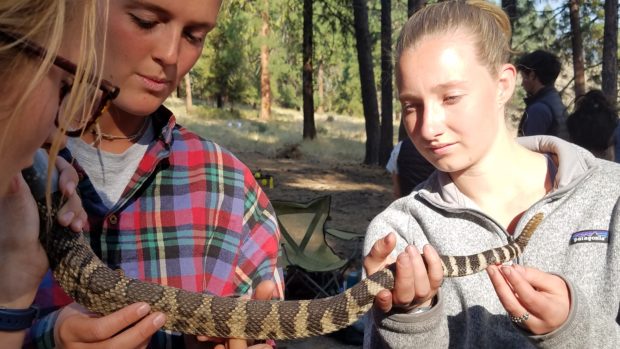We have much more to do and your continued support is needed now more than ever.
Swimming with Salmon, Splashing with Beavers
Immersive Learning in the Methow Valley

Preparing for our beaver pond vigil, Professor Phil Brick expressed some doubt that a group of nearly two dozen lively and excited college students would be able to sit silently for a full hour at dusk. “Put on your layers now, and don’t bring your phones,” he cautioned, adding that even the sound of zippers might scare off the beavers we hoped to watch emerging in the evening light.
The students, participants in Whitman College’s landmark immersive learning program, Semester in the West, joked and jostled as they made their way to the pond’s edge, but immediately settled into their camp chairs with barely a rustle. Soon they were rewarded with one and then a pair of beavers swimming in long patrols parallel to the shore, clearly sniffing and peering at the visitors but only occasionally registering alarm with a loud tail slap and dive underwater.
It was a fitting end to a day that included an exploration of a marshy, frog-filled beaver-pond complex in a tributary of the Methow River in north-central Washington. At the direction of Kent Woodruff, one of the founders of the Methow Beaver Project, 21 student-scientists waded, splashed, and scratched their way through lush vegetation in a hunt for clues about the watershed.

Their findings? This headwater stream–once a dried-up channel in the late summer–was transformed into a vibrant home for birds, frogs, bear and moose after the Methow Beaver Project released a pair of beavers whose busy work was less welcome elsewhere. Now, just two years later, the dams built and maintained by the beavers have effectively slowed seasonal runoff, providing ponds and a higher water table to support lush stands of aspen, willow, wild rose and other native trees and shrubs.
Kent queried the students and wove their observations into an integrated picture of complex ecosystem “machinery” at work (see sidebar for examples), highlighting the key role of beavers as ecosystem engineers.
The next day, we gathered in a large circle at the students’ campsite on the Washington Department of Fish and Wildlife’s Methow Wildlife Area, embarking on a wide-ranging, interactive conversation about beavers, watershed restoration, climate change, and conservation strategy. Best of all, we were joined by Ben Goldfarb, author of the acclaimed new book, Eager: The surprising secret life of beavers and why they matter, who memorably described Kent Woodruff as “The Beaver Whisperer.”

The Methow Valley was one stop among dozens on the Semester in the West students’ trek across the interior West, an exhaustive (frequently exhausting) immersion in natural resources conflicts, values and solutions. The undergraduates selected for participation in this wildly popular program spend an entire semester on the road, sleeping in tents, sharing their encounters in online profiles and photos, and supported by a high-tech converted horse trailer complete with solar panels, satellite communications, and a full office with library resources for research and writing.
Before they departed the Methow Valley, the “Westies” had the opportunity to swim with salmon in a local river, handle and learn about rattlesnakes, spend a memorable day on a windy ridge with a raptor monitoring team, and meet philanthropists and political leaders whose efforts to protect this valley and beyond date back to some of the first spotted owl surveys and fights over ski area development in the 1970s.

The National Wildlife Federation hosts multiple programs to engage children, their families and communities with nature. It’s particularly satisfying to connect with college students focusing full-time on the landscape, wildlife and people of the West. We’re depending on their passion and commitment to finding sustainable solutions to lead us into the next era of conservation.
At the very least, they know how to sit quietly and pay attention.
Help support the Northern Rockies and Pacific Region’s continued efforts to help wildlife in a rapidly changing world through educational programming:
DONATE




















